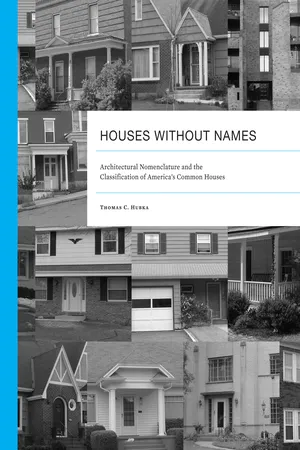
eBook - ePub
Houses without Names
Architectural Nomenclature and the Classification of America's Common Houses
- English
- ePUB (mobile friendly)
- Available on iOS & Android
eBook - ePub
Houses without Names
Architectural Nomenclature and the Classification of America's Common Houses
About this book
In countless neighborhoods across America, the streets are lined with houses representing no established architectural style. Many of the 80 million homes in the United States today have only loose-fitting, general names like ranch, duplex, bungalow, and flat. Most, however, cannot even be identified by these common names, much less by an architectural type such as Colonial, Italianate, or Queen Anne. The few regionally recognized vernacular terms— shotgun, Cape (Cod), three-decker, and the like—remain exceptions rather than the rule. In this innovative, copiously illustrated guide, Thomas C. Hubka considers why most ordinary, working-class houses lack an adequate identifying nomenclature and proposes new ways to name and classify these anonymous structures, shedding a fresh light on their role in the development of American domestic culture and its housing landscape.
Popular, developer-built, tract, speculative, everyday—whatever they are called, these common homes constitute the largest portion of American housing in all regions and historic periods. Without classification, these dwellings tend to be left out of histories of American building, neglected in preservation surveys and plans, and ignored when it comes to considering their impact on American culture. Current methods of interpreting common houses need not be replaced, Hubka shows, but only modified to include a
broader, more complete spectrum of common dwellings. As Hubka explains, by applying an order of census and a floor-plan analysis, scholars can adequately characterize the actual homes in which most Americans live, particularly in recent times after the widespread growth of suburban homes.
Based on years of field observations, measured drawings, and surveys of regional house types, this handbook provides a working vocabulary for the study and appreciation
of America¹s common houses and will prove useful to preservationists, academics, and architects, as well as owners and residents of America¹s most ubiquitous residences.
Popular, developer-built, tract, speculative, everyday—whatever they are called, these common homes constitute the largest portion of American housing in all regions and historic periods. Without classification, these dwellings tend to be left out of histories of American building, neglected in preservation surveys and plans, and ignored when it comes to considering their impact on American culture. Current methods of interpreting common houses need not be replaced, Hubka shows, but only modified to include a
broader, more complete spectrum of common dwellings. As Hubka explains, by applying an order of census and a floor-plan analysis, scholars can adequately characterize the actual homes in which most Americans live, particularly in recent times after the widespread growth of suburban homes.
Based on years of field observations, measured drawings, and surveys of regional house types, this handbook provides a working vocabulary for the study and appreciation
of America¹s common houses and will prove useful to preservationists, academics, and architects, as well as owners and residents of America¹s most ubiquitous residences.
Frequently asked questions
Yes, you can cancel anytime from the Subscription tab in your account settings on the Perlego website. Your subscription will stay active until the end of your current billing period. Learn how to cancel your subscription.
At the moment all of our mobile-responsive ePub books are available to download via the app. Most of our PDFs are also available to download and we're working on making the final remaining ones downloadable now. Learn more here.
Perlego offers two plans: Essential and Complete
- Essential is ideal for learners and professionals who enjoy exploring a wide range of subjects. Access the Essential Library with 800,000+ trusted titles and best-sellers across business, personal growth, and the humanities. Includes unlimited reading time and Standard Read Aloud voice.
- Complete: Perfect for advanced learners and researchers needing full, unrestricted access. Unlock 1.4M+ books across hundreds of subjects, including academic and specialized titles. The Complete Plan also includes advanced features like Premium Read Aloud and Research Assistant.
We are an online textbook subscription service, where you can get access to an entire online library for less than the price of a single book per month. With over 1 million books across 1000+ topics, we’ve got you covered! Learn more here.
Look out for the read-aloud symbol on your next book to see if you can listen to it. The read-aloud tool reads text aloud for you, highlighting the text as it is being read. You can pause it, speed it up and slow it down. Learn more here.
Yes! You can use the Perlego app on both iOS or Android devices to read anytime, anywhere — even offline. Perfect for commutes or when you’re on the go.
Please note we cannot support devices running on iOS 13 and Android 7 or earlier. Learn more about using the app.
Please note we cannot support devices running on iOS 13 and Android 7 or earlier. Learn more about using the app.
Yes, you can access Houses without Names by Thomas C. Hubka in PDF and/or ePUB format, as well as other popular books in Architecture & Architecture General. We have over one million books available in our catalogue for you to explore.
Information
Table of contents
- Cover
- Title Page
- Copyright Page
- Contents
- Foreword
- Preface
- 1 | Houses without Names: The Problem of Interpreting America’s Common Houses
- 2 | Underlying Themes for Understanding Common Houses
- 3 | Emphasizing the Floor Plan in Common Houses
- 4 | Identifying the Floor Plan from the Outside
- 5 | Houses with Names: Interpreting America’s Common Houses
- Notes
- Index